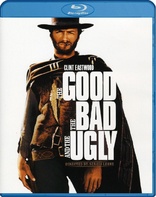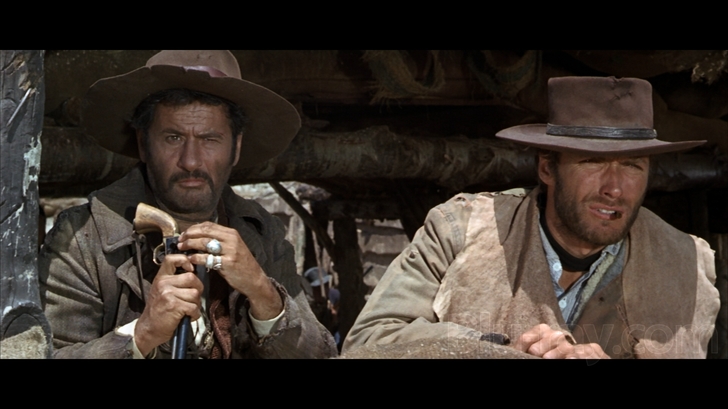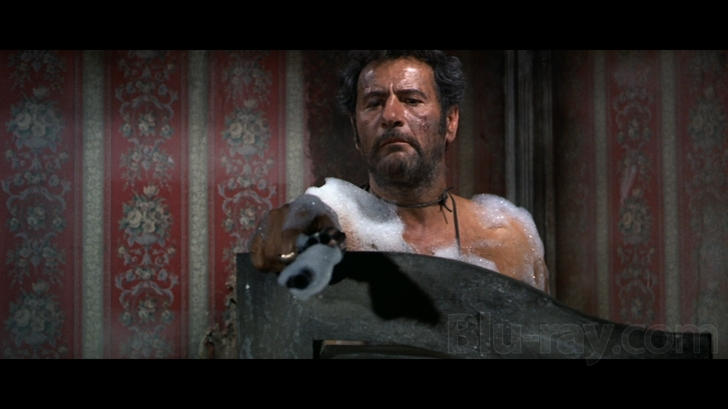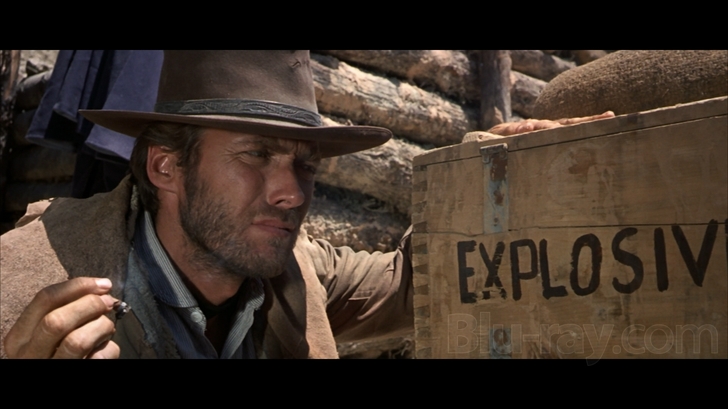The Good, the Bad and the Ugly Blu-ray Movie
HomeThe Good, the Bad and the Ugly Blu-ray Movie 
Il buono, il brutto, il cattivoMetro-Goldwyn-Mayer | 1966 | 179 min | Rated R | May 12, 2009

Price
Movie rating
9 | / 10 |
Blu-ray rating
| Users | 4.3 | |
| Reviewer | 4.5 | |
| Overall | 4.3 |
Overview
The Good, the Bad and the Ugly (1966)
A bounty hunting scam joins two men in an uneasy alliance against a third in a race to find a fortune in gold buried in a remote cemetery.
Starring: Clint Eastwood, Eli Wallach, Lee Van Cleef, Aldo Giuffrè, Mario BregaDirector: Sergio Leone
| Drama | Uncertain |
| Period | Uncertain |
| Epic | Uncertain |
| Western | Uncertain |
| Adventure | Uncertain |
Specifications
Video
Video codec: MPEG-4 AVC
Video resolution: 1080p
Aspect ratio: 2.35:1
Original aspect ratio: 2.35:1
Audio
English: DTS-HD Master Audio 5.1 (48kHz, 24-bit)
German: DTS 5.1
French: Dolby Digital 5.1
Portuguese: Dolby Digital 5.1
Spanish: Dolby Digital 5.1
Italian: Dolby Digital Mono
Thai: Dolby Digital 2.0
English: Dolby Digital Mono
English Mono = Downmix from 5.1
Subtitles
English SDH, German, Portuguese, Spanish, Cantonese, Korean, Mandarin (Traditional), Thai
Discs
50GB Blu-ray Disc
Single disc (1 BD)
Playback
Region free
Review
Rating summary
| Movie | 4.5 | |
| Video | 3.0 | |
| Audio | 3.0 | |
| Extras | 3.5 | |
| Overall | 4.5 |
The Good, the Bad and the Ugly Blu-ray Movie Review
“When you have to shoot, shoot. Don’t talk!”
Reviewed by Casey Broadwater June 10, 2009When John Wayne rode the plains, life was pretty simple for a gunslinger. Heroes wore white hats and treated their women kindly, while villains sauntered into town in ten-gallons worth of black, their upper lips hardened into permanent sneers. The Law of the West was a balancing act between freedom and justice. Good was good, bad was bad, and moral ambiguity just plain hadn’t been invented yet. The reality of westward expansion, however, was a great deal less grounded in ethical certainties, and I’ve always thought the myth of the noble West was a ploy to help us feel better about what we did to the Native Americans. Hollywood embraced the western for its easy-to-script, good vs. evil, let’s get out there and show ‘em how Americans get ‘r done ethos, but after churning out title after title, the formula began to lose its potency. In the meantime, Europeans—who had never even been to the wild, wild West—were putting new spins on the genre and paying close attention to what might as well be called the Eastern. Yes, the samurai film. Inspired by the ronin, masterless swordsmen who plied their steel-edged trade for cold hard cash, Sergio Leone would create a different kind of western, where good was relative and bad was more than just an attitude. For the traditional Hollywood cowpoke tale, things were about to get ugly.

"I've never seen so many men wasted so badly."
The culmination of this new breed of western is undoubtedly The Good, the Bad and the Ugly. As the third film in Leone’s “Dollar” trilogy—which MGM’s marketing division would erroneously label “The Man with No Name Trilogy,” not noticing that Clint Eastwood has a name in all three films—The Good, the Bad and the Ugly presents Leone at the height of his creative and directorial powers, not to mention blessed with the biggest budget he’d had yet. The scope of the film is immense, as Leone takes us from tiny towns to embroiled Civil War battles, and from the craggy canyons of the characters’ faces to sand-filled vistas that stretch from one horizon to the next. Even time itself seems subject to the film’s enormity. At a hefty 179 minutes, The Good, the Bad and the Ugly should seem drawn-out and overlong. Instead, we’re drawn into the tense and protracted stares between characters, waiting anxiously for that split-second moment of violence. A lesser film would’ve left whole spools on the cutting room floor, but each spare detail here builds up the world that the narrative inhabits.
Set in Texas on the outskirts of the Civil War, The Good, the Bad and the Ugly is the story of three men vying to find $200,000 in Confederate gold. Blondie (Clint Eastwood) is the Good, an itinerant gunslinger who’s running a scam with Tuco (Eli Wallach)—the Ugly—a conniving bandit well practiced in the art of backstabbing, and the two have a tenuous alliance based on mutual gain. Also after the coinage is Angel Eyes (Lee Van Cleef)— the Bad—a cold-blooded killer with an icy stare that’s like looking down the dual barrels of a shotgun. Tuco knows the cemetery where the money is buried, but not the exact location. Blondie knows the spot, but not the name of the cemetery. And Angel Eyes tracks them both, hoping to get his hands on the glittering payday. Allegiances flip-flop and niceties are quickly dispensed with as the three men get nearer and nearer to the treasure.
That our hero (or is it anti-hero?) Blondie is after money—not justice—is indicative of the new, cynical direction that Leone was taking with his westerns. Decency and integrity were no longer adequate rewards, in and of themselves, and though Blondie is the Good in the film, he’s rarely “good” in the conventional sense. Tuco is the most blatantly rapacious—when he gets to the cemetery he’s basically running around with dollar signs in his eyes—but Blondie is also driven inherently by greed. This materialistic hunt is set against a backdrop of war’s absurdities— thousands of soldiers die to take an inconsequential bridge—and Leone seems to be saying that both war and greed are surefire routes to senseless violence.
And there’s plenty of fun, senseless violence. More than just an upheaval of its genre, The Good, the Bad and the Ugly is an ultra-cool exercise in style, from the cleverly cut gun battles to Clint Eastwood in his knee-length duster, squinting into the sun with a half-smoked stogie wedged in his grimacing teeth. The three principle actors are simply a pleasure to watch. Lee Van Cleef simmers with a dastardly suaveness, Eastwood brings his wry smile, and Eli Wallach stomps through the narrative, often stealing the show from Clint himself. There’s a reason why people still watch The Good, the Bad and the Ugly, and it’s not because the film is influential or game-changing, but simply because it’s so damn entertaining and watch-able.
The Good, the Bad and the Ugly Blu-ray Movie, Video Quality 

MGM's 1080p/AVC-encoded transfer of The Good, the Bad, and the Ugly is by no means perfect, and it pales in comparison to Mondo's Italian release of the film, but for U.S. viewers, this is the best we're going to get until someone ponies up the cash for a new remaster. The Good, the Bad and the Ugly rides off through the desert in dusty Technicolor hues, with the pale blue sky looming overhead. Black levels are mostly strong, giving the film a brawny dimensional presence, and there only a few scenes that look mildly washed out or crushed. MGM's transfer, which is based off a 2002 restoration, is not nearly as crisp as Mondo's, but the stubble on leathery faces is rendered fairly clearly, and textures, like cloth, show fine detail, all without the telltale signs of edge-enhancement. I should note though, that in several of the close-ups, the actors seem to step a bit too close to the lens and the focus becomes uncharacteristically soft. Additionally, some of Leone's staple wide shots also have a mild fuzziness. As The Good, the Bad and the Ugly is over forty years old, the print does show some expected wear and tear. White specks dot the screen fairly frequently, two or three hairs get stuck on the print, and at the 1:29:39 mark some strange yellow stains mar the image for several seconds. The thin, nearly unnoticeable layer of grain also testifies to some post-production tweaking, mostly in the form of DNR, but the scrubbing isn't as egregious here as it is in some other waxier, more smeary titles, like Patton, for instance, or The Sixth Sense. Still, if any DNR is a deal-breaker for you, you might want to sit this one out. Here's to hoping that MGM acquires Mondo's more-pristine transfer sometime in the near future and brings it stateside.
The Good, the Bad and the Ugly Blu-ray Movie, Audio Quality 

While the film's visual presentation won me over at first glance, The Good, the Bad and the Ugly's DTS-HD MA 5.1 surround track is somewhat trickier to judge. During the restoration process, audio technicians took the original mono mix and expanded it to 5.1 channels, a difficult process considering that the sound effects and music were all contained on one track and were effectively inseparable. The end result is a listenable experience that nonetheless shows the dated tech of its source materials. Since all of the voices and sound effects were dubbed in after shooting, elements of the audio often have a canned and compressed range. Just listen to the wind whipping over the dust in the opening sequence, or the tinny patter as the Confederates pull out of town with their cannons in tow. High-end sounds, like the electric guitar in Ennio Morricone's influential score, are overly brash, and bass only gets a chance to rumble during cannon blasts and other sundry explosions. The track is expectedly front-heavy, with the rear channels used mostly for bleeding ambience and score. Voices are clear for the most part, though I often found myself cringing at some of the not-so-subtle ADR work. Still, I always feel a bit unfair putting older films to the test of my modern ears, and for its age and source materials, The Good, the Bad and the Ugly, while never wowing, sounds perfectly acceptable.
The Good, the Bad and the Ugly Blu-ray Movie, Special Features and Extras 

Commentary Tracks
Two commentaries are included on the disc, the first by film historian Richard Schickel, which
appeared on the DVD release, and the second by Christopher Frayling, writer of Spaghetti
Westerns: Cowboys and Europeans from Karl May to Sergio Leone. Both men are veritable
Leone experts, and each track is laden with insights, critical dissections, and anecdotes, with
some expected overlap. Frayling's is the livelier track, but both commentaries will prove
invaluable to spaghetti western fans.
Leone's West (SD, 19:55)
This retrospective look at Leone's westerns, specifically the so-called "Man With No Name Trilogy,"
features Clint Eastwood, Eli Wallach, producer Alberto Grimaldi, dubbing expert Mickey Knox, and
film historian Richard Schickel. A lot of the material discussed is also covered in the more
extensive commentary tracks, but those looking for a concentrated, less time consuming dose
will find this featurette highly informing. I was particularly amused by the fact that Clint
Eastwood brought most of his own costume to the set, including his black Levi jeans, gun belt,
and that distinctive sheepskin jacket.
The Leone Style (SD, 23:48)
Featuring the same cast of interviewees as the previous feature, "The Leone Style" is basically a
way to break the bonus materials into more digestible chunks. This morsel is naturally focused on
the look of Leone's films and how, with an almost child-like view of the world, he drew inspiration
from painting and opera.
The Man Who Lost the Civil War (SD, 14:24)
Many viewers might assume the Civil War skirmishes that surround the film's narrative are
fictional, but they were based on some actual battles fought on the far western front of the war.
This brief documentary is focused on Brigadier General Henry Hopkins Sibly, who had a grand
scheme to give the Confederacy an open route to California, and win the acknowledgement of
France and England.
Restructuring The Good, the Bad and the Ugly (SD, 11:09)
In 2002, MGM Technical Services and Triage Labs, a company that focuses on photo-chemical
restoration and obscure formats, set about restoring the extended version of the film, a daunting
task that was done almost completely by hand. This segment gives some insight into that
process.
Il Maestro: Ennio Morricone and The Good, the Bad and the Ugly
This segment is broken into two parts. The first, in standard definition and clocking in at 7:48, is
an interview with film music historian Jon Burlingame, who discusses Morricone's avante-guard
influences and the unique score of the film. Part two, which is about 12 minutes, is an audio-only
dissection by Jon Burlingame of Morricone's themes from The Good, the Bad and the
Ugly.
Deleted Scenes (SD, 10:19)
Included are the extended Tuco torture sequence and the Socorro sequence, which is pieced
together from still photography and shots from the French trailer for the film.
Trailers (SD, 3:21)
Includes the original theatrical trailer and the French trailer.
The Good, the Bad and the Ugly Blu-ray Movie, Overall Score and Recommendation 

If you're even remotely a fan of westerns, there's no reason not to own The Good, the Bad and the Ugly. The film looks stellar on Blu-ray, and while the audio won't blow you away or anything, you'll be whistling Morricone's coyote-inspired theme for days. Highly Recommended.
Other editions
The Good, the Bad and the Ugly: Other Editions

The Good, the Bad and the Ugly
Il Buono, il brutto, il cattivo
1966

The Good, the Bad and the Ugly
DVD Packaging / Il Buono, il brutto, il cattivo
1966

The Good, the Bad and the Ugly
Il Buono, il brutto, il cattivo
1966

The Good, the Bad and the Ugly
Il buono, il brutto, il cattivo | Remastered
1966

The Good, the Bad and the Ugly
Il buono, il brutto, il cattivo | 50th Anniversary Edition
1966

The Good, the Bad and the Ugly
Deadpool Photobomb Series / Deadpool 2 Movie Cash
1966

The Good, the Bad and the Ugly
Deadpool Slipcover
1966

The Good, the Bad and the Ugly 4K
Il buono, il brutto, il cattivo
1966

The Good, the Bad and the Ugly
Il buono, il brutto, il cattivo | Remastered
1966

The Good, the Bad and the Ugly
1966
Similar titles
Similar titles you might also like

A Fistful of Dollars 4K
Per un Pugno di Dollari
1964

For a Few Dollars More 4K
1965

Once Upon a Time in the West 4K
Standard Edition | C'era una volta il West 4K
1968

The Searchers 4K
Warner Archive Collection
1956

The Proposition
2005

Unforgiven 4K
1992

True Grit
2010

Ride Lonesome
1959

The Wild Bunch
1969

My Darling Clementine
Theatrical and Prerelease Versions
1946

The Treasure of the Sierra Madre
1948

The Revenant 4K
2015

How the West Was Won
1962

The Beguiled
1971

Dances with Wolves
20th Anniversary Edition | Extended Cut
1990

Decision at Sundown 4K
1957

One-Eyed Jacks
1961

Guns of the Magnificent Seven
1969

The Magnificent Seven 4K
1960

Winchester '73
1950